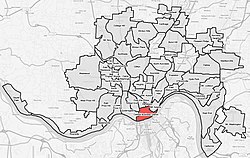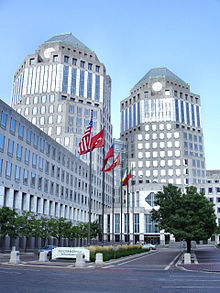Neighborhood in Cincinnati, Ohio, United States
| Downtown | |
|---|---|
| Neighborhood | |
 Downtown Cincinnati viewed from Mt. Adams Downtown Cincinnati viewed from Mt. Adams | |
 Location within Cincinnati Location within Cincinnati | |
| Country | United States |
| State | Ohio |
| City | Cincinnati |
| Elevation | 660 ft (201 m) |
| Population | |
| • Total | 5,835 |
| Time zone | UTC-5 (EST) |
| • Summer (DST) | UTC-4 (EDT) |
| ZIP code | 45202 |
| Website | Downtown Cincinnati |
Downtown Cincinnati is one of the 52 neighborhoods of Cincinnati, Ohio. It is the central business district of the city, as well as the economic and symbiotic center of the Cincinnati metropolitan area. Originally the densely populated core of the city, the neighborhood was transformed into a commercial zone in the mid-20th century. The population was 5,835 at the 2020 census.
History
Main article: History of Cincinnati| This section needs additional citations for verification. Please help improve this article by adding citations to reliable sources in this section. Unsourced material may be challenged and removed. (December 2023) (Learn how and when to remove this message) |
Downtown was the densely populated core of Cincinnati in the 19th and 20th centuries. The basin was amongst the most densely populated areas of any city in the United States from 1860 to 1900. It remained a large share of the city's overall population until urban renewal and highways tore up much of urban fabric in the 1950s and 1960s.
Geography
Downtown Cincinnati is laid out on a basin on the Ohio River, surrounded by steep hills. Downtown Cincinnati's streets are arranged on a grid. Streets are split between the east and west by Vine Street. Bridges from Downtown Cincinnati span the Ohio River across to Covington and Newport in Northern Kentucky.
The city government defines the neighborhood's northern boundary with Over-the-Rhine and Pendleton as East Central Parkway, the northwestern boundary with West End as Plum Street, the western boundary with Queensgate as Interstate 75, and the eastern boundary with Mount Adams as Eggleston Avenue.
Demographics
| Year | Pop. | ±% | ||
|---|---|---|---|---|
| 1840 | 36,946 | — | ||
| 1850 | 38,970 | +5.5% | ||
| 1860 | 53,752 | +37.9% | ||
| 1870 | 51,393 | −4.4% | ||
| 1880 | 42,820 | −16.7% | ||
| 1890 | 36,076 | −15.7% | ||
| 1900 | 24,800 | −31.3% | ||
| 1910 | 20,050 | −19.2% | ||
| 1920 | 15,475 | −22.8% | ||
| 1930 | 12,443 | −19.6% | ||
| 1940 | 11,497 | −7.6% | ||
| 1950 | 12,126 | +5.5% | ||
| 1960 | 5,953 | −50.9% | ||
| 1970 | 3,472 | −41.7% | ||
| 1980 | 2,528 | −27.2% | ||
| 1990 | 3,846 | +52.1% | ||
| 2000 | 3,189 | −17.1% | ||
| 2010 | 4,850 | +52.1% | ||
| 2020 | 5,835 | +20.3% | ||
| ||||
| Wards were utilized from 1840-1890 which have slightly different boundaries from census tracts utilized from 1900-40. | ||||
As of the census of 2020, there were 5,835 people living in the neighborhood. There were 4,147 housing units. The racial makeup of the neighborhood was 68.0% White, 17.9% Black or African American, 0.1% Native American, 6.4% Asian, 0.1% Pacific Islander, 1.7% from some other race, and 5.7% from two or more races. 4.7% from two or more races.
There were 2,639 households, out of which 17.2% were families. 64.4% of all households were made up of individuals.
2.7% of the neighborhood's population were under the age of 18, 92.0% were 18 to 64, and 5.3% were 65 years of age or older. 37.6% of the population were male and 62.4% were female.
According to the U.S. Census American Community Survey, for the period 2016-2020 the estimated median annual income for a household in the neighborhood was $90,027. About 4.2% of family households were living below the poverty line. About 68.1% had a bachelor's degree or higher.
Economy
Downtown has long been the economic hub of Cincinnati. In the mid-nineteenth century, 16 of the city's 24 banks were located on Third Street near the busy Public Landing river port. Towards the end of the nineteenth century, the center of business activity moved to Fourth Street, closer to where it remains today.
Kroger, Fifth Third Bank, Procter & Gamble, Western & Southern Financial Group, American Financial Group, and Cincinnati Bell are all headquartered in Downtown Cincinnati.
The Duke Energy Convention Center is the convention center of Cincinnati. Opened in 1968, it offers 750,000 square feet (70,000 m) of meeting space.
Government
The Cincinnati City Hall is located downtown on Plum Street. The Hamilton County Courthouse is connected to the Hamilton County Justice Center via a skybridge.
Cityscape



Downtown Cincinnati is marked by its large collection of historic architecture and contains several historic districts and dozens of buildings on the National Register of Historic Places.
All but one of the twenty-five tallest buildings in Cincinnati are located in Downtown Cincinnati. The Carew Tower had a public observation deck on the forty-ninth floor, though it has since closed.
Since 1971, the Cincinnati Skywalk has connected buildings throughout downtown via a series of primarily indoor, elevated walkways. The Skywalk was officially completed as a 1.3 mile contiguous path in 1997, but has since fallen into disfavor by city leaders, and some sections have been removed.
Culture
| This section needs additional citations for verification. Please help improve this article by adding citations to reliable sources in this section. Unsourced material may be challenged and removed. (December 2023) (Learn how and when to remove this message) |
Downtown Cincinnati is an increasingly residential area with former commercial space, such as Park Place at Lytle, being converted into luxury condos.
Museums downtown include the high-rise Contemporary Arts Center, National Underground Railroad Freedom Center, and the Taft Museum of Art.
The Banks is a waterfront mixed-use development hosting bars and restaurants. It is especially crowded following games at the adjacent Paycor Stadium and Great American Ball Park, the stadiums of the Cincinnati Bengals and Cincinnati Reds.
The Backstage District that sprang up around the Aronoff Center contains nightlife and dining options.
Parks
| This section needs additional citations for verification. Please help improve this article by adding citations to reliable sources in this section. Unsourced material may be challenged and removed. (December 2023) (Learn how and when to remove this message) |
Often considered to be the heart of Cincinnati, Fountain Square is located in the center of the Central Business District. The 1871 dedicated Tyler Davidson Fountain stands prominently on the often busy city square. Other city parks located Downtown are Lytle Park and Piatt Park.
Infrastructure
Downtown is a transportation hub for the entire region. Downtown is served by Fort Washington Way which connects interstates 71 and 75 with Route 50.
Southwest Ohio Regional Transit Authority operates public transportation with its transit hub at Government Square. The downtown area is also served by the Connector, a streetcar line that connects downtown with Over-the-Rhine.
See also
References
- ^ "Downtown 2020 Statistical Neighborhood Approximation" (PDF). City of Cincinnati. Retrieved December 14, 2023.
- Winternitz, Felix; et al. (2007). Insiders' Guide to Cincinnati. Globe Pequot. p. 5. ISBN 9780762741809. Retrieved May 8, 2013.
- Felix Winternitz & Sacha DeVroomen Bellman (2007). Insiders' Guide to Cincinnati. Globe Pequot. p. 24. ISBN 9780762741809. Retrieved May 8, 2013.
- "Reported Crime". City of Cincinnati. Retrieved January 21, 2024.
- Quinn, James; Eubank, Earle; Elliott, Lois (1947). Population changes--Cincinnati, Ohio, and adjacent areas 1900- 1940. Bureau of Business Research, the Ohio State Univ. in co-operation with the City of Cincinnati, and the Dept. of Sociology. OCLC 3094332. Retrieved February 16, 2024.
- Enquirer, Cincinnati. "A neighborhood comparison: Population (2020)". The Enquirer. USA Today. Retrieved February 16, 2024.
- Census, US. "Population Publications (1790-2020)". US Census. US Census. Retrieved February 16, 2024.
- Jones, Kent; et al. (July 18, 2011). Historic Downtown Cincinnati. Arcadia Publishing. p. 81. ISBN 9780738582917. Retrieved May 4, 2013.
- Federal Writers' Project (1943). Cincinnati, a Guide to the Queen City and Its Neighbors. p. 156. ISBN 9781623760519. Retrieved May 4, 2013.
- "10 Fortune® 500 companies call Greater Cincinnati "home"!". Cincinnati Chamber. Retrieved February 21, 2017.
- Alltucker, Ken (June 1, 2003). "Downtown skywalk falls into disfavor". Cincinnati Enquirer. Retrieved March 30, 2015.
- Ball, Jennifer (June 2007). "Selling Points". Cincinnati Magazine. p. 87. Retrieved May 6, 2013.
External links
39°6′N 84°31′W / 39.100°N 84.517°W / 39.100; -84.517
Categories: